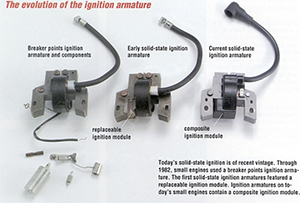Have you ever looked at a wiring diagram for a Briggs & Stratton engine and felt like you were staring into a jumbled mess of lines and symbols? You’re not alone. These diagrams can seem intimidating, but they hold the key to understanding how the ignition system works and how to troubleshoot any issues. This guide will lead you through the intricacies of Briggs & Stratton ignition coil wiring diagrams, unlocking the secrets of these important components.
Image: diagramqu.blogspot.com
Briggs & Stratton engines are ubiquitous, powering lawnmowers, generators, and much more. Each engine relies on a meticulously crafted ignition system to deliver the spark needed to ignite fuel and power the engine. The ignition coil plays a vital role in this process, converting low-voltage electricity from the engine’s electrical system into high-voltage sparks. Understanding the wiring diagram allows you to diagnose problems, perform maintenance, and even understand modifications.
Navigating the Maze: Deciphering the Symbols and Components
The Key to the Code: Understanding the Symbols
Like any map, a wiring diagram uses symbols to represent different components. Here’s a breakdown of common symbols you’ll encounter on a Briggs & Stratton ignition coil wiring diagram:
- Ignition Coil: Often depicted as a rectangular shape with a coil-like symbol inside.
- Battery: Represented by a symbol with a “+” and “-” terminal.
- Ignition Switch: Usually a rectangular shape with a keyhole inside.
- Spark Plug: A circular symbol with a central dot representing the electrode.
- Ground: A symbol resembling a triangle with a horizontal line beneath it.
- Wires: Represented by lines with arrows indicating the direction of current flow.
- Capacitor: A rounded shape with two lines extending outward.
- Resistor: Represented as a zigzag line or a rectangular shape with diagonal lines.
Mapping Out the Journey: Typical Ignition Coil Wiring
While the exact configuration can vary based on the engine model, most Briggs & Stratton ignition coil systems share common connections. Here’s a typical layout:
- Battery Connection: A wire from the positive terminal of the battery is connected to the “+” terminal on the ignition coil.
- Ignition Switch Connection: A wire from the ignition switch, which controls the flow of electricity to the system, connects to the ignition coil.
- Spark Plug Connection: A wire from the high-voltage terminal of the ignition coil is connected to the center electrode of the spark plug.
- Ground Connection: The negative terminal of the battery or a separate ground wire is connected to the “-” terminal on the ignition coil, completing the electrical circuit.

Image: money-sense.net
From Theory to Practice: Real-World Troubleshooting
Armed with an understanding of the wiring diagram, you can tackle common ignition problems. Here’s how:
No Spark: Pinpointing the Culprit
A lack of spark is often due to a faulty ignition coil, but other components can be responsible. The wiring diagram acts as your roadmap for diagnosing the problem:
- Check the Spark Plug: Ensure the spark plug is correctly installed and in good condition.
- Test the Ignition Coil: Use a spark tester or a multimeter to verify that the coil is producing a high-voltage spark when the engine is cranked.
- Inspect the Ignition Switch: Ensure the ignition switch is functioning properly and making a good electrical connection.
- Check for Broken Wires: Inspect the wiring for any visible breaks, shorts, or loose connections.
- Evaluate the Battery: Ensure the battery has sufficient charge to power the ignition system.
Engine Misfiring: Unraveling the Issues
Misfiring can occur due to a variety of problems, and the wiring diagram helps isolate the cause:
- Check Spark Plug Gaps: Ensure the spark plug gap is within the recommended specifications for your engine.
- Inspect the Ignition Coil: Look for signs of damage or corrosion on the coil. A faulty coil can cause intermittent spark and misfire problems.
- Verify the Ignition Timing: Incorrect ignition timing can lead to engine misfire. Refer to your engine’s manual for proper timing adjustments.
- Test the Fuel System: A fuel delivery issue can also cause a misfire. Check fuel lines, filters, and carburetor for obstructions or leaks.
Beyond the Basics: Taking Your Knowledge Further
For more advanced troubleshooting and maintenance, you can delve deeper into the specifics of your engine model. Briggs & Stratton offers detailed service manuals and wiring diagrams online, providing additional information and troubleshooting steps. These manuals are invaluable resources for anyone who wants to take their understanding of Briggs & Stratton ignition systems to the next level.
Embrace the Power of Online Communities
Another valuable resource is the vast network of online forums and communities dedicated to Briggs & Stratton engine enthusiasts. Here, you can connect with knowledgeable individuals who can offer specific advice, share their repair experiences, and help you decipher complex wiring diagrams. These communities are a testament to the enduring popularity of Briggs & Stratton engines and the willingness of enthusiasts to share their knowledge.
Think Outside the Box: Modifying and Upgrading
For those seeking more performance or customization, understanding the wiring diagram allows for modifications. You can upgrade to a more powerful ignition coil or modify the wiring to accommodate aftermarket components. Always proceed with caution and ensure the modifications are compatible with your engine model to avoid damaging the system. Remember, safety should be your top priority when working with electrical systems.
Schematic Briggs And Stratton Ignition Coil Wiring Diagram
Conclusion
Navigating a Briggs & Stratton ignition coil wiring diagram may seem like an intricate puzzle, but equipped with the right knowledge and tools, the task becomes manageable. By understanding the symbols, tracing the flow of electricity, and learning about common troubleshooting steps, you can confidently diagnose and address problems. This knowledge empowers you to keep your Briggs & Stratton engine running smoothly, ensuring a reliable source of power for your projects and adventures. Remember, continue exploring, seeking out resources, and engaging with online communities to refine your skills and become a true Briggs & Stratton engine expert.





